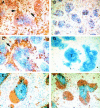Autoantigen-specific B cell activation in Fas-deficient rheumatoid factor immunoglobulin transgenic mice
- PMID: 10477549
- PMCID: PMC2195612
- DOI: 10.1084/jem.190.5.639
Autoantigen-specific B cell activation in Fas-deficient rheumatoid factor immunoglobulin transgenic mice
Abstract
In systemic autoimmune disease, self-tolerance fails, leading to autoantibody production. A central issue in immunology is to understand the origins of activated self-reactive B cells. We have used immunoglobulin (Ig) transgenic mice to investigate the regulation of autoreactive B cells with specificity for self-IgG2a (the rheumatoid factor [RF] specificity) to understand how normal mice regulate RF autoantibodies and how this fails in autoimmune mice. We previously showed that normal mice do not tolerize the AM14 RF clone, nor do they appear to activate it. Here we show that in Fas-deficient autoimmune mice, the picture is quite different. RF B cells are activated to divide and secrete, but only when the autoantigen is present. Thus, B cells that are ignored rather than anergized in normal mice can be stimulated to produce autoantibody in Fas-deficient mice. This demonstrates a novel developmental step at which intact Fas-Fas ligand signaling is required to regulate B cells in order to prevent autoimmunity. These data also establish the relevance of ignorant self-specific B cells to autoantibody production in disease and prove that in the case of the RF specificity, the nominal autoantigen IgG2a is the driving autoantigen in vivo.
Figures






References
-
- Tan E.M. Antinuclear antibodiesdiagnostic markers for autoimmune diseases and probes for cell biology. Adv. Immunol. 1989;44:93–151. - PubMed
-
- Madaio M.P., Carlson J., Cataldo J., Ucci A., Migliorini P., Pankewycz O. Murine monoclonal anti-DNA antibodies bind directly to glomerular antigens and form immune deposits. J. Immunol. 1987;138:2883–2889. - PubMed
-
- Raz E., Brezis M., Rosenmann E., Eilat D. Anti-DNA antibodies bind directly to renal antigens and induce kidney dysfunction in the isolated perfused rat kidney. J. Immunol. 1989;142:3076–3082. - PubMed
-
- Lefkowith J.B., Gilkeson G.S. Nephritogenic autoantibodies in lupus. Arthritis Rheum. 1996;39:894–903. - PubMed
-
- Chan O., Shlomchik M.J. A new role for B cells in systemic autoimmunityB cells promote spontaneous T cell activation in MRL-lpr/lpr mice. J. Immunol. 1998;160:51–59. - PubMed
Publication types
MeSH terms
Substances
Grants and funding
LinkOut - more resources
Full Text Sources
Other Literature Sources
Molecular Biology Databases
Research Materials
Miscellaneous

